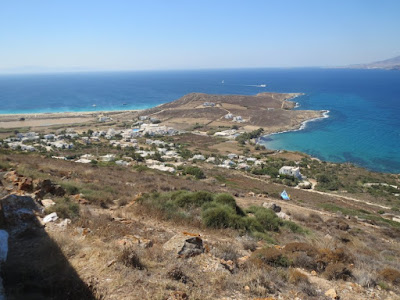Kalo Mina! Now that we have arrived at June it’s time for our archaeological projects to take the field. This summer from Makedonia to the Kyklades to the Argolida and points in between there are Canadians who are conducting surveys, excavating sites and studying the finds from previous field seasons.
At ancient Argilos on the coast in Makedonia Dr. Zisis Bonias and Professor Jacques Perreault have started fieldwork relating to a new five-year research plan in their long-running synergasia. They have purchased a new plot immediately to the east of the Koutloudis Sector bordering the old National Road. Here they will continue uncovering the many-roomed Building L as well as probably other structures dating from the late 6th through mid-4th centuries BC.
At Kastro Kallithea in southern Thessalia Dr. Sofia Karapanou and Professor Margriet Haagsma are in the second year of a program of study and analysis of the artifacts and the ecofacts as well as the architecture that they recovered in the course of the excavations of Building 10 and of the Stoa in the Agora as part of their synergasia.In eastern Boiotia the Eastern Boeotia Archaeological Project [EBAP] is completing their first five-year research program involving the excavation of ancient Eleon (modern Arma). This synergasia between Dr. Alexandra Harami, and Professors Brendan Burke and Bryan Burns will excavate the other portion of the so-called LH I/II “Blue Stone Structure” revealed last summer in the Southeast Sector on the acropolis.
In the northwestern Argolida the Western Argolid Research Project [WARP] is conducting the second of three years of intensive “site-less” survey in the Inachos river valley. Professors Dimitri Nakassis, Scott Gallimore and Sarah James are seeking to find evidence of occupation and resource exploitation from the Neolithic period through the 20th century of our era. Their research zone covers what was, on and off, part of the hinterland of ancient Argos.Finally, at Stelida on Naxos in the Kyklades a new five-year project began late last month as a synergasia between Dr. Dimitris Athanasoulis and Professor Tristan Carter. This is a continuation of the research at the site which began as an intensive survey in 2013 and 2014. In their test trenches they are attempting to uncover undisturbed archaeological strata so that they can find suitable organic and stone materials to date, using various chronometric techniques, what are probably Lower, Middle and Upper Palaeolithic artifacts, tool production debitage and quarrying debris that cover the slopes of this hill.
If you wish to see in person one or more of the 2014 fieldwork projects carried out under the aegis of the Institute contact directly the Canadian co-directors/directors for details on how and when you could arrange a visit.
Kala kai polla evremata vre paidia!!!
Cordially,
David Rupp
Director






No comments:
Post a Comment